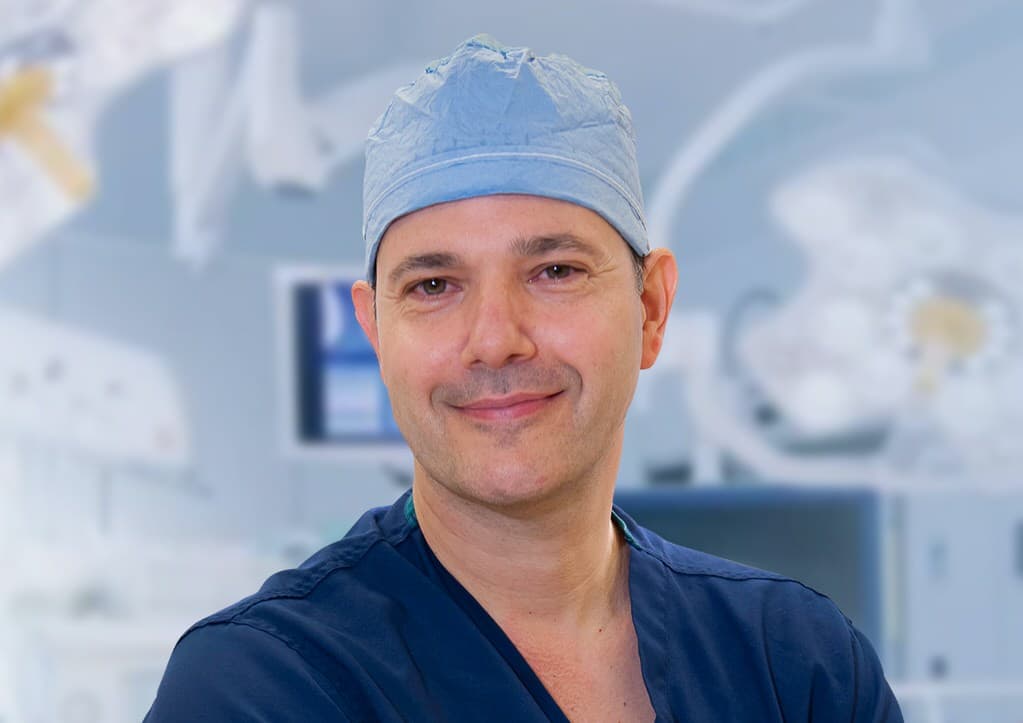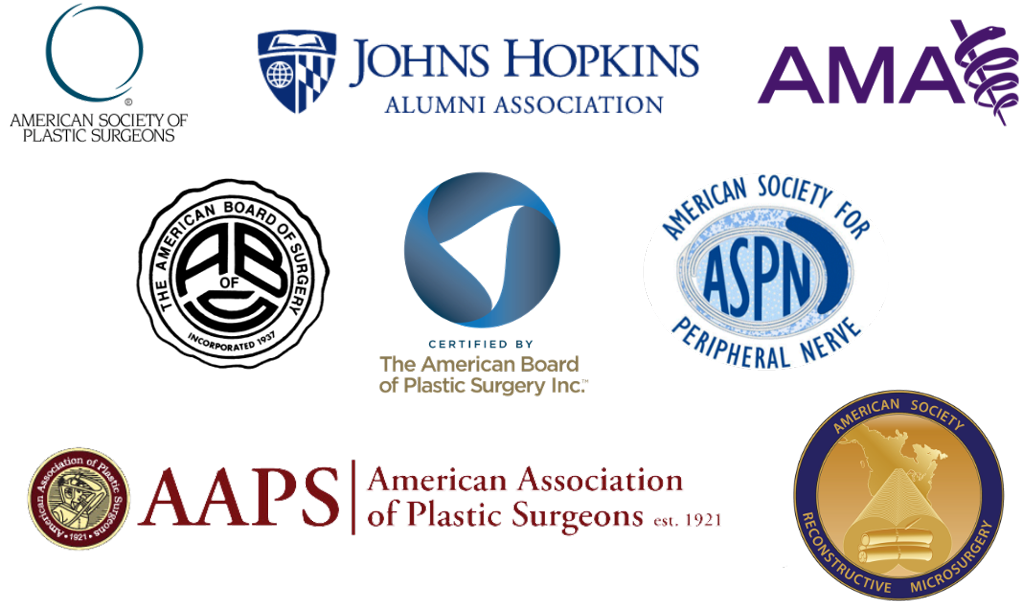Shai M. Rozen, M.D., F.A.C.S.
1801 Inwood Road
Dallas, TX 75390
Phone: (214) 645-2353
Monday–Friday: 8 a.m.–5 p.m.
Rhinoplasty
Rhinoplasty is a facial plastic surgery procedure that can improve the appearance and functioning of the nose. Dr. Shai Rozen is a board-certified plastic surgeon and leading facial paralysis specialist at the University of Texas Southwestern Medical Center who performs rhinoplasty in Dallas to help patients with and without facial paralysis breathe more freely and feel more confident.
How can facial paralysis affect nasal breathing?
Several facial muscles are involved in keeping the airways of the nose open and preventing the nose from collapsing when breathing, including:
- Nasalis
- Depressor septi
- Levator labii superioris alaeque nasi muscles
Other facial muscles may also indirectly affect nasal opening. When these muscles are paralyzed, patients often have difficulty breathing through the side of the nose on the affected side of the face.
Why do many patients with facial paralysis need rhinoplasty?
Due to paralysis of the muscles mentioned above, the 2 nasal valves that assist in maintaining an open nasal airway, the internal and external nasal valves, tend to narrow and collapse, respectively, especially during strong nasal inhalation or side sleeping. One of the tests that patients can do on their own is to pull the affected cheek upwards and to the side and examine whether this helps their nasal breathing. Very frequently, patients use nasal strips during sleep to assist nasal breathing.
Are there any additional factors that may affect breathing?
Other common variables that may obstruct the nasal airway and affect breathing in patients with and without facial palsy include:
- Structural deformities of the septum (the dividing structure between the nostrils) such as septal deviation
- Enlarged nasal turbinates
- Allergies may cause constant irritation and thickening of the nasal mucosa
Dr. Rozen will examine and analyze all of these possibilities to optimize surgical planning.
What is the primary strategy in rhinoplasty for patients with facial paralysis?
For facial paralysis patients, Dr. Rozen performs rhinoplasty to widen the internal nasal valve passage and provide structural support to the external nasal valve. During the surgery, he inserts cartilage, called spreader grafts and nasal alar grafts, into specific areas of the nose. Obviously, every case should be individually analyzed because many patients have additional anatomical abnormalities that might contribute to airway obstruction. Addressing all abnormalities will optimize results.
Dr. Shai Rozen
Dr. Rozen is a board-certified plastic surgeon who co-created a facial paralysis specialty group with colleagues from otolaryngology & neurosurgery at the University of Texas Southwestern Medical Center.
Meet Dr. Rozen
Can you improve the aesthetics of my nose during functional nose surgery?
Yes, Dr. Rozen can perform aesthetic nasal surgery, such as reshaping the tip of the nose or making the nose straighter, at the same time as functional nasal surgery. He actually prefers to perform cosmetic and functional rhinoplasty at the same time for a variety of reasons, including:
- Planning is easier.
- Performing the procedures usually requires the same exposure.
- Combining procedures into a single surgery is safer than performing an additional procedure in the future.
- Limiting recovery to a single period of healing time.
Will insurance cover both the reconstructive and cosmetic part of the surgery?
Most functional surgeries that improve breathing will be covered by insurance. Cosmetic nasal surgery is not covered by insurance.
What is considered cosmetic surgery of the nose?
Any procedure that is related to improvement in the shape and appearance of the nose is considered cosmetic surgery. Most procedures that may help nasal function are considered reconstructive.
Where is cartilage for cosmetic and functional nasal surgery taken from?
Cartilage can be taken from several sources.
Nasal Septum
The most common is from the nasal septum. The advantage is that septal surgery is very common during rhinoplasty and therefore doesn’t necessitate taking cartilage from other areas. The downside is that it provides a limited amount of cartilage which may be insufficient for the specific patient’s need.
Rib
If septal cartilage is insufficient, Dr. Rozen usually prefers to use a very small portion of rib cartilage. The many advantages include:
- The incisions can be well hidden and will heal well.
- There is no noticeable donor site.
- There is enough cartilage for any needed procedure.
- The cartilage can be carved into any shape.
The disadvantages are that patients may have a small amount of pain after surgery (which is well-controlled with pain medications), and an additional incision, albeit well-hidden, is required.
Cadaver Rib
Cadaver ribs are treated and cleaned, so they only have the connective tissue (structural) component, not the cells, and therefore are not prone to rejection. The advantage, similar to autologous rib cartilage (rib from the patient’s own body), is that there is always a sufficient amount of cartilage. Also, there is no donor site on the patient. The small disadvantage is that we do not know if some of this cartilage will dissipate (decrease in size) over time, though this may not be important since the structural support may be important mainly in the first year after surgery until soft tissue healing (scarring) in position is more permanent. Also, some patients don’t like the fact that the cartilage is sourced from cadavers.
Ear
The advantage of taking cartilage from the ear is that it is within the same surgical field, and its removal doesn’t cause any noticeable deformity. Disadvantages include:
- Ear cartilage has a curved shape.
- There is a limited amount of cartilage in the ear.
- A dressing is needed on the ear after surgery.
Where are the incisions in rhinoplasty?
In most patients, rhinoplasty involves a very small and nearly imperceptible incision in the columella (the structure between the nostrils) and incisions on the inside of the nose, which can’t readily be seen. In certain cases when smaller nasal changes are required, incisions can be limited to the inside of the nose.
Are sutures removed after surgery?
Columellar sutures are removed in 5 to 7 days. The sutures inside the nose are absorbable and don’t need removal.
How long does it take to recover from rhinoplasty?
Recovery time partially depends on the amount of work done during surgery. If the surgery involves planned and deliberate fracturing of the nasal bones (this is usually needed for aesthetic purposes and not for functional nasal palsy surgery), there is more swelling and bruising around the eyes.
Regardless of the extent of the rhinoplasty, swelling and bruising are expected, and the majority should resolve within 4 to 6 weeks. The more work that is performed in rhinoplasty, the more swelling occurs. It is important to understand that because of the sebaceous character of the nasal skin, complete resolution of swelling actually takes a year or slightly longer, though over 90% decreases in the first 3 months. The very final result of the rhinoplasty is seen after 12 to 18 months when the tip becomes more defined.
Does every rhinoplasty involve fracturing the nasal bones?
No. The most common reason for fracturing the nasal bones is to narrow the superior vault (upper third) of the nose for aesthetic reasons – aligning the dorsal aesthetic lines. Other reasons involve correction of a deviation or an open roof deformity, the latter may occur after reducing a dorsal hump. It is rarely needed in cases of airway obstruction due to facial paralysis and is done mainly if patients desire aesthetic improvements that benefit from fracturing.
Can reanimation procedures of the face improve breathing enough that rhinoplasty is not needed?
This is a complex issue and is truly patient-specific. Certain reanimation procedures we perform will help with nasal breathing, such as reinnervation procedures via nerve transfers or muscle flaps and fascial grafts. Whether these procedures help enough differs among patients and likely depends on the severity of paralysis and other pre-existing causes of nasal airway obstruction. Although the additional nasal surgery improves nasal breathing in most patients, some patients won’t need it, and therefore we tend to perform rhinoplasty later in the treatment strategy after we’ve evaluated response to previous treatments.
Should I proceed with rhinoplasty?
This is a very personal decision. If you have breathing problems related to your facial paralysis, relieving the obstruction may significantly improve your quality of life. If you also have something that bothers you about the shape of your nose, it may be an excellent opportunity to address your concerns and improve the look of your nose. At the end of the day, the goals are always to improve function and make patients feel good about themselves. For patients with facial paralysis, this goal is further augmented since the ultimate purpose is to get as close as possible to normal and sometimes better, both functionally and aesthetically, via small steps and accurate planning.
Next Steps
For more information about functional and cosmetic rhinoplasty, request a consultation to meet with Dr. Rozen at UT Southwestern.



